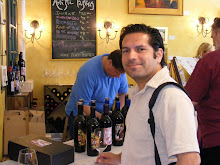
Last weekend began an epic journey of the scents, flavors, and products of Mexican gastronomy. The Aromas y Sabores 2011,Ruta del Norte, highlights the rich heritage of the north.This is the third such culinary tour of Mexico. I'm currently in Monterrey,Nuevo Leon on an 11-day run that will realize a much anticipated journey on El Chepe, the legendary train-ride on the the Copper Canyon Railroad. Been waiting all my life for this.
In a pre-dawn ribbon cutting ceremony, reknowned chef,cookbook author, and Mexican culinary ambassador, Patricia Quintana of Mexico City's Izote,presented an international group of chefs, journalists, writers, photographers,bloggers, and tourism representatives to a delicious endeavour:to know Mexico's cultural treasures and to imprint into our memories its aromas and flavors.

The symbol of the sacred New Fire of Mezoamerica, El Nuevo Fuego, was rather appropriate on this trip, as Mexico's gastronomy was recently formally recognized by UNESCO as an intangible cultural heritage.
It's time for everyone to light the cultural fires in the fine dining restaurants of Condesa and Polanco, to save the treasures found in Mexico's markets from succumbing to commercialization, to document and promote the 32 distinct regional cuisines of Mexico found in its fondas, cenadurias, and street stands.Mexican cuisine is in its New Fire.

We started the tour with a visit to Mexico City's largest Mercado de Abastos, wholesale food and miscellaneous goods market, to have a look see, smell, and taste.
The Mercado de Abastos was completed in 1982 and is considered a city within a city at 810 acres of market.It was constructed to meet the food demands of the world's second largest city as the Mercado Merced wasn't big enough to satify the population, and was congested with traffic.
The market continues a spirit and tradition that has existed since prehispanic times.
We walked through the trail of tears, a football field length corridor of garlic and onions, so important in Mexican cookery. We took in the scents of countless chile varieties, all fighting for our nasal attention; hibiscus flowers from all over Mexico ready to be boiled and turned into one of the most famous aguas frescas in the world, agua de jamaica.
I lured Chef Patricia over to a fascinating tortilla machine where she ended up making us each a taco de sal, a tortilla with a little bit of salt, rolled into a taquito.
She was full of every and enthusiam the entire day, immaculately garbed in traditional Mexican regional dress.

The Mercado de Abastos, being a city within a city even had its own spokesmodels to accompany us on our market tour:Deborah, Cintia, Sandra, and Rebeca.

We saw a film about the market in its theater and were treated to a breakfast that reminded us of Mexico's culture of corn; quesadillas came in yellow, green, red, and blue corn.We were surrounded by Mexico's aromas and flavors, provoked by its colors, and entertained by its hard working vendors.This remarkable experience, a magical day in Mexico City would continue with a once in a lifetime lunch at a nearby convent.

The prehispanic buffet at the former Convent of Culhuacan.It was like going to market in the year 1518,give or take a few ingredients here and there. An unforgettable lunch in Iztapalapa.

The art of the comal and tortilla.

Oaxacan Mezcal made in earthen pots using a prehispanic distillery, following traditional methods. There's undeniable evidence that distilling practices existed before the Spanish came, but more on that at another time. This mezcal was gorgeous, earthy, and mineral.

Sopes de Chapulines, fresh masa sopes layered with beans, grasshoppers, and crumbled queso fresco.

Cerdo con Verdolagas, a Mexico City staple dish of pork with purslane in a tomatillo sauce. This is a must try when in Mexico City, but on this day just seemed ordinary when compared to the bounty of rare dishes at this feast.

Tortitas de Ahuautle, water bug larvae patties with nopales,tomato, green chile, onions,cilantro, and garlic bound by beaten eggs.

Ancas de Rana, frog's legs in tomatillo sauce with chilacoyote, a local squash.

Charales Iztapalapenses, small dried lake fish stewed in tomatillo sauce with nopales and potatoes.

Artichokes were brought to Mexico by the Spanish, but Alcachofas Iztapalapenses are a local invention; artichokes are fried with manchego and quesillo cheeses tucked inside, walnuts too, and bathed in a tomato sauce. Amazing!

Huevera de Gallina,hard-boiled hen egg yolks with menudencias(offal), nopales, onions, and garlic.

Pato en Pipian, duck in a thick, ingredient leaden pumpkin seed sauce.

Quesadilla de Quelites, a blue corn masa quesadilla filled with wild greens foraged nearby in Iztapalapa.

Tlapique de Pescado, found in the markets of Xochimilco, and Iztapalapa in Mexico City, also in Toluca. Normally a whole fish cooked over coals covered in epazote and chile guajillo using natural parchment, corn husks. This is a type of tamal.

Prior to this royal banquet, we ascended the Cerro de la Estrella, a prehispanic site where the Nuevo Fuego ritual is still performed we participated in a ceremony to pay respect to our ancestors, our heritage, our land.
It's time to know Mexico, it's culture, its wealth of sensorial gifts. Come with us as we continue this taste Odyssey, the revolucion shall be twitterized.
Aromas y Sabores on twitter
Chef Patricia Quintana on twitter








No comments:
Post a Comment